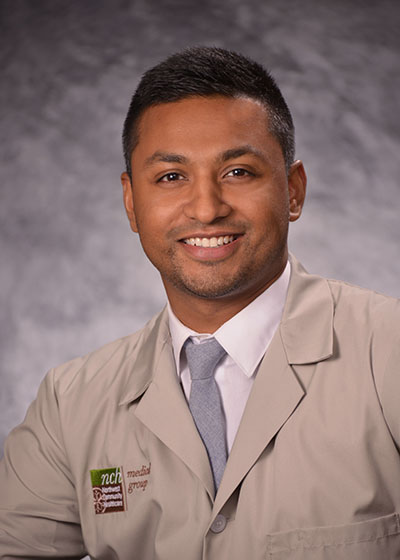Do you have pain? It could be one of two types of arthritis
February 20, 2019
Many people who reach middle age start to feel the creaks in their bones. It’s really the joints beginning to wear out. Like brakes on a car when the pads wear thin, protective cartilage between bones can break down or your immune system may attack the soft tissue that lubricates your joints. NCH Medical Group Rheumatologist Jimmy Varghese, M.D. explains two common types of arthritis with similar symptoms.
Rheumatoid arthritis

What is rheumatoid arthritis?
It is an autoimmune disease, which means your body is basically attacking itself.
What are the symptoms of rheumatoid arthritis?
A patient may have joint pain, swelling and prolonged stiffness. There could be fatigue and loss of energy.
What body parts are affected?
Typically, it’s seen in the hands and feet. Most commonly, it tends to attack small joints and it tends to be very symmetrical, meaning both sides are affected. It can also occur in the knees, hips and shoulders.
Is rheumatoid arthritis similar to other types of arthritis?
Sometimes rheumatoid arthritis could be confused with osteoarthritis because they have some similar symptoms, but osteoarthritis tends to have less swelling and stiffness. It can mimic gout.
How can you tell the difference?
There is some overlap between where rheumatoid and osteoarthritis could surface. We rely on what patients tell us about their symptoms. We look for whether it’s just stiffness or if it’s pain or swelling. They do overlap.
Can you describe how rheumatoid arthritis feels?
Everyone experiences pain differently, but most say it’s a chronic, throbbing pain that is worse at the beginning of the day and tends to lessen throughout the day the more you’re using the affected joints.
What treatment is recommended?
With rheumatoid arthritis there are several medications that are disease-modifying, anti-rheumatic drugs. It all depends on how bad the symptoms are. NSAIDs can help symptoms but they don’t treat the disease. That’s an important feature to understand because we need to try to treat the rheumatoid arthritis.
What causes it?
We don’t know what causes it. For whatever reason, the body attacks itself. There may be a genetic component or environmental factors that can be associated with it, and also smoking can increase your risk for developing rheumatoid arthritis.
Osteoarthritis
Can you describe osteoarthritis?
Osteoarthritis is the most common type of arthritis. It’s the age-related, degenerative arthritis that we see in people as they get older. Typically, middle aged and elderly people are affected.
Why do patients develop this?
Over time, you get wear and tear of the joints. You have loss of cartilage. Joints start narrowing and begin to touch each other and that’s what causes the pain and discomfort.
Why is there confusion between rheumatoid and osteoarthritis?
The pain can be similar and can affect similar joints.
How do you tell the difference in the pain?
Osteoarthritis is painful in the morning, there’s not much swelling associated with it, and it gets worse the more you work the affected joints. Rheumatoid arthritis tends to feel better the more you use your joints.
How is osteoarthritis treated?
It’s treated with physical therapy, weight loss (if the patient is overweight) and pain medications like Tylenol or NSAIDS. Depending on how bad or advanced it is, sometimes patients need joint replacement surgery. In cases where the pain is impacting a patient’s life, we will refer that patient to an orthopedic surgeon for possible surgical intervention.
When should you see a physician for arthritis pain?
Patients should see a physician if the pain doesn’t seem to be getting better with over-the-counter treatments and/or if they’ve noticed a lot of swelling in their joints in particular.
What specific areas of the body are affected by osteoarthritis?
The hands, feet, knees and hips tend to be the most commonly affected areas. You can get it in your spine, while rheumatoid arthritis can affect the neck. We have imaging available to help identify affected areas.
What is a first-time visit to a rheumatologist like?
We collect a good history and listen to the symptoms to see if it’s inflammatory or mechanical. We do an exam of all the joints to see how they move. We see what the problems with the joints themselves are, and sometimes we do blood tests to see what may be going on.
Dr. Jimmy Varghese practices at 1051 W. Rand Road, Suite L02 in Arlington Heights and 199 W. Rand Road in Mount Prospect. To schedule an appointment, call 847-725-8401.